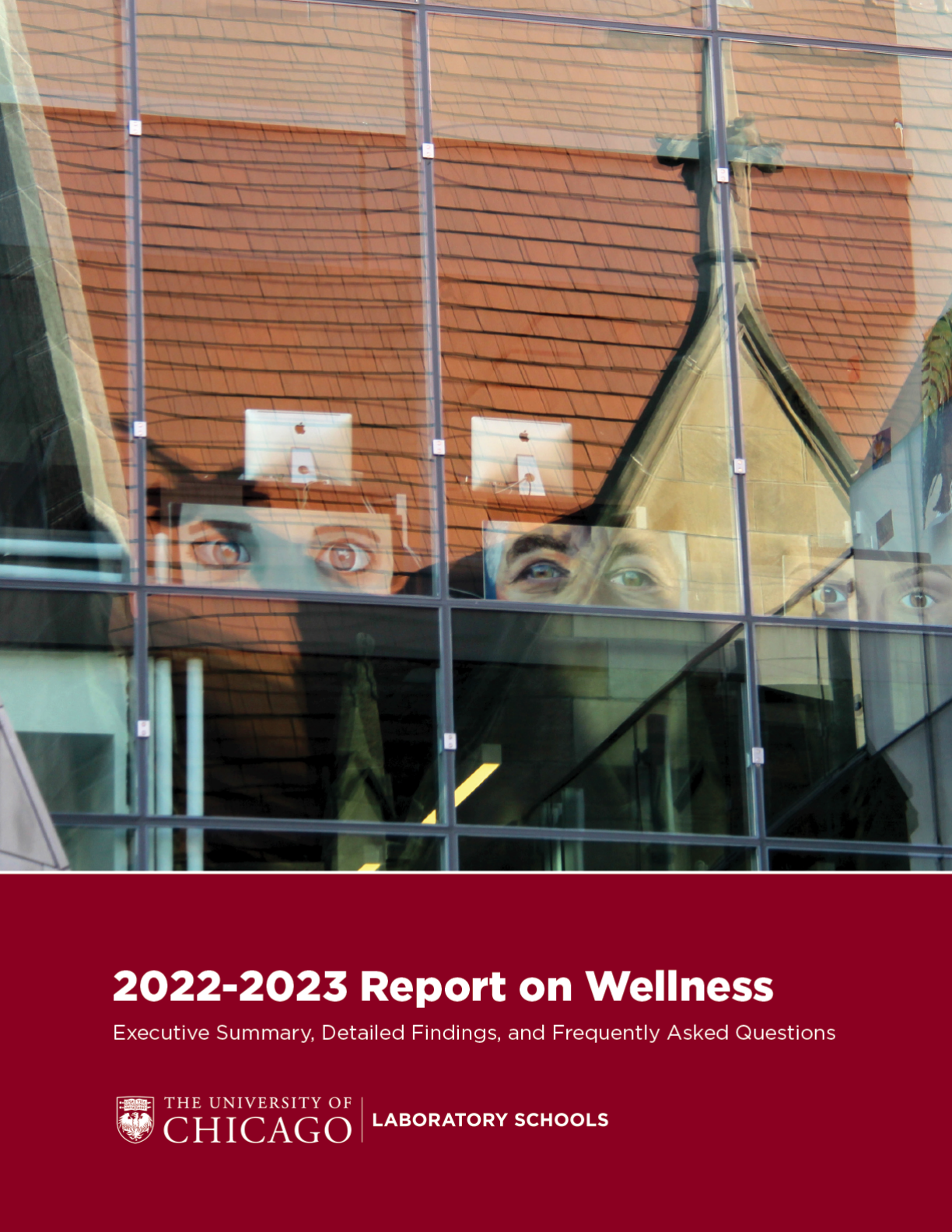

Table of Contents
I. Executive Summary 3
INTRODUCTION 3
METHODOLOGY AND TERMINOLOGY 4
KEY FINDINGS 5
EXPERT RECOMMENDATIONS 7
MENTAL HEALTH SUPPORT AT THE LABORATORY SCHOOLS 8
Ongoing Initiatives 8
Planned/Upcoming Initiatives 10
CONCLUSIONS 11
II. Detailed Findings 12
Participation rate and comparison schools 12
Well-Being Index and Mental Health Symptoms 13
Prevalence of Anxiety and Depression 14
Prevalence of Rule-Breaking and Substance Use Behaviors 16
Prevalence of Feelings of Isolation at School 17
Correlations and Focus Areas 18
School Climate 18
Students’ Relationships with Peers 22
Students’ Relationships with Parents/Guardians 25
Student Responses to Open-Ended Questions 29
Areas of Strength 29
Areas for Improvement 29
Students’ Concerns 30
Ways to Increase Equity and Inclusion 31
III. Frequently Asked Questions 33
Why did Lab choose to partner with Authentic Connections? 33
What is the Well-Being Index? 33
What can we do to increase students’ participation in the survey? 34
Where did the gender identity descriptors come from? 34
How did Lab determine which questions to ask (and not ask) this year? 34
Who oversees wellness at Lab? 35
What is Lab’s plan for conducting surveys in the future? 35
Where do I go if I have a concern? 35
Page 2/35

2022-2023 Report on Wellness
I. Executive Summary
INTRODUCTION
In confronting mental health concerns among our young people, the Laboratory Schools are not alone.
Schools and families across the country are grappling with a crisis in youth mental health. This national
crisis, described as “devastating” by the Surgeon General, has been underway for several years but was
amplified by the COVID-19 pandemic.
At Lab, we intend to meet this crisis with the most rigorous, community-wide effort possible, drawing on
our mission priorities of creativity, kindness, and experiential learning. Our aspiration is that Lab’s
response will include efforts by all constituencies—educators among our faculty and staff, students, and
their parents and guardians—and will set the standard for other schools and communities.
Given the gravity of this crisis, it is critically important that we develop a fine-grained understanding of
its nuances, driving factors, and correlations. Thus, for our most recent biennial health and wellness
survey, Lab chose to partner with Authentic Connections, a highly regarded national organization of
research professionals with expertise in youth mental health, which has collaborated with hundreds of
schools like ours.
This three-part report sets forth the findings and recommendations provided by Authentic Connections
following the administration of its High Achieving Schools Survey at Lab in the fall of 2022:
● This Executive Summary provides a narrative explanation and summary;
● The Detailed Findings section provides precise data on the top takeaways;
● Our FAQ anticipates questions that Lab community members may have.
Meeting this crisis will require that every member of our community develop and maintain a high level
of awareness, alertness, and empathy for the needs of our young people at this time. Whether you are a
faculty member, administrator, staff member, parent or guardian, or student, thank you for reading this
report carefully and joining the effort.
Page 3/35

METHODOLOGY AND TERMINOLOGY
This report reflects the methodology developed by Authentic Connections, and uses our partner’s
terminology. In the fall survey, Lab students were asked quantitative and open-ended questions about
well-being symptoms and aspects of student life. Middle and High School students participated in the
survey at a rate of 87%.
Researchers at Authentic Connections used Lab students’ answers to generate our school’s overall
Well-Being Index in comparison to other schools, and to discern the prevalence of clinically significant
symptoms of mental health difficulties. Students’ answers were also used to inform Authentic
Connections’ conclusions about mental health correlations at Lab—that is, which aspects of student life
most closely correlate with well-being symptoms—and to develop focus areas for our school to prioritize.
Finally, these correlations were used to develop recommendations for further work by the adult
members of our community, both at school and at home.
Page 4/35

KEY FINDINGS
Well-Being Index: Lab’s overall mental health and wellness tracks the national norm
Lab scored 85% on the Authentic Connections Well-Being Index. This index measures overall mental
health and wellness among our student body. Our score tracks closely with the national norm of 85.5%,
with 100% being the highest score possible for the healthiest student bodies.
For the strength and resilience indicated by this measure, we credit the sustained efforts of our
educators, the compassion for peers that prevails among our students, and the partnership of our parent
and guardian community. However, given the severity of our national crisis, we must recognize that at
this time, average is not good enough. Furthermore, the details below highlight areas that require
concerted, ongoing attention both within our schools and across our community.
Symptoms: Feelings of anxiety, depression, and low feelings about school are above the norm at Lab,
and some mental health symptoms are related to personal identity
Authentic Connections’ survey measured the prevalence at Lab of five clinically significant symptoms
related to student mental health: (1) anxiety; (2) depression; (3) rule-breaking behaviors; (4) substance
use; and (5) isolation at school. Below is a summary of the prevalence of these symptoms among Lab
students in Grades 6-12. Where Authentic Connections provided Lab with precise numbers for a
symptom, we have shared those numbers here.
● Anxiety: 12.6% of Lab students were found to have experienced anxiety symptoms in the past six
months, a rate of prevalence that is above the national norm of 8.1%.
● Depression: 9.2% of students were found to have experienced depression symptoms in the past
six months, above the national norm of 7.1%.
● Rule-breaking Behaviors: 4.6% of Lab students had engaged in rule-breaking behaviors in the
past six months, below the national norm of 5.1%.
● Substance Use (monthly): Lab students were below national norms by every measure in this
category (“During the last thirty days, on how many occasions have you… drank alcohol? ...used
marijuana? ...vaped? ...smoked cigarettes? …been drunk?”)
● Isolation at School: To assess whether students experienced high isolation at school/low feelings
about school in the past six months, they were asked questions about five topics: how much
they desired to be at school, whether they felt like they belonged, if they felt overcommitted,
and whether they were made to “feel bad” at school either by adults or by fellow students. Lab
students were at or near national norms for all measures except that 30.6% of our students
reported a “low desire to be in school” in the past six months, which was markedly higher than
the national norm of 25.1%.
Correlations and Focus Areas: Equity/inclusion, social media, parent standards, and other aspects of
student life are highly correlated with mental health concerns at Lab, and should be our top priorities
Through a detailed data analysis, Authentic Connections identified nine aspects of student life which are
most closely correlated with mental health concerns at Lab.
Page 5/35

To clarify, these issues are not necessarily highly or unusually prevalent at Lab. Rather, their significance
lies in the fact that they are so closely related to the symptoms described above. In other words,
students who reported experiencing these aspects of student life were likely also to report experiencing
mental health symptoms—anxiety, depression, rule-breaking, substance use, or isolation at school/low
feelings about school. Where our community can improve these nine aspects of student life, we stand a
good chance of seeing an improvement in well-being symptoms among our young people. Thus, these
correlations must become our focus areas.
Among Lab students, the prevalence of several of these key issues is linked with facets of students’
personal identities. More precisely, students who identify with historically marginalized personal
characteristics are the most likely to be afflicted by several of these symptoms. For example, Lab
students who identify as Black are more likely to experience high ethnic discrimination than their peers.
Our community must take careful note of such links to personal identity, to galvanize our ongoing work
in inclusion and belonging. Where there are significant correlations between symptoms and facets of
personal identity, they are described in the Detailed Findings section below.
Authentic Connections has grouped these issues under three categories: school climate, students’
relationships with peers, and students’ relationships with their parents/guardians. This categorization
underscores the notion that every constituency in the Lab community—students, faculty, staff, and
parents/guardians—has a role to play in improving the mental health of our students.
School Climate
● Equity/Inclusion: Students’ feelings of low equity and inclusion correlate strongly with
mental health symptoms at Lab. (12% vs. national norm of 8%.)
● Ethnic Discrimination: Students’ experiences of high ethnic discrimination correlate
strongly with mental health symptoms at Lab. (9% vs. national norm of 8%.)
● School Standards: Students’ feelings “that the teachers and adults at school are overly
critical, disapproving, and impossible to please” correlate strongly with mental health
symptoms at Lab. (12% vs. national norm of 8%.)
Students’ relationships with peers
● Peer Victimization: Students’ experiences of bullying, harassment, or exclusion by peers
correlate strongly with mental health symptoms at Lab. (2% vs. national norm of 6%.)
● Adverse Social Media Comparison: Students’ experiences of feeling worse about
themselves after viewing others’ social media correlate strongly with mental health
symptoms at Lab. (33% vs. national norm of 39%.)
● Sexual Harassment: Students’ experiences of peer sexual harassment correlate strongly
with mental health symptoms at Lab. (4% vs. national norm of 4%.)
Page 6/35

Students’ relationships with parents/guardians
● Low Parent Mood: Students’ perceptions that their parents seem depressed, tired,
stressed, or irritable correlate strongly with mental health symptoms at Lab. (4% vs.
national norm of 3%.)
● Lenient Parent Consequences for Drugs: Parents’/guardians’ permissive rules or lenient
consequences regarding drug and alcohol use correlate strongly with student mental
health symptoms at Lab. (5% vs. national norm of 8%.)
● Hyper-Parenting over Grades: Students’ experiences of feeling more upset than cared
for when talking to their parents about grades correlate strongly with mental health
symptoms at Lab. (23% vs. national norm of 19%.)
EXPERT RECOMMENDATIONS
Having identified which aspects of student life correlate most strongly with mental health symptoms,
and based on their work with schools across the nation, Authentic Connections has made the following
recommendations for the adults in our community—both at school and at home.
We are gratified to observe that many of these recommendations have already been enacted at Lab
(please see “Ongoing Initiatives,” below) and in students’ homes. Educators, parents, and guardians
should be commended for all the hard work they have done to date in supporting our young people and
in modifying our habits to meet this crisis. And yet, we can all work to ensure that these
recommendations are ever more deeply ingrained in our culture and practices, individually and
collectively.
Recommendations for faculty, administrators, and staff at Lab:
● Coordinating student workload: The volume and scheduling of assignments should be
coordinated across the faculty and program of studies in each division, to ensure a manageable
workload on a week-by-week basis, and students should be encouraged to reach out when too
much is assigned.
● Maintaining school standards with a flexible approach: Teachers should maintain high
expectations but make it clear that academic and extracurricular success should never come at
the expense of student well-being.
● Ensuring student-adult relationships that boost belonging: The school should ensure that
students have access to empathetic adults with whom they can truly “be themselves,” and
students should be asked directly who these adults are.
● One-on-one emotional support for students: The school should maintain a list of students who
may need a check-in from an adult, and ensure that each student is contacted by an adult who
knows them. The school should maintain clear policies around confidentiality when it comes to
mental health conversation to ensure that students feel comfortable approaching faculty and/or
counselors with mental health issues.
Recommendations for parents and guardians of Lab students:
Page 7/35

● Ensuring a measured, supportive, loving approach to children’s grades: Parents and guardians
should consider a family discussion about grades to come to an agreement on the frequency,
tone, and messaging of these conversations.
● Delivering mindful consequences for substance use: Parents and guardians should have
discussions with each other about appropriate responses to alcohol, tobacco, and drug use, and
should consider that while overly strict rules can backfire, an excessively lenient approach
erodes the boundaries young people need as they grow through adolescence.
● Engaging in parent/guardian self-care: Because young people are so responsive to their
parents’/guardians’ moods, the adults in the household are encouraged to engage in self-care.
This could take a variety of forms depending on a family’s needs and habits, from individual or
group therapy to regular exercise to taking advantage of opportunities to connect and socialize
with other parents at Lab.
MENTAL HEALTH SUPPORT AT THE LABORATORY SCHOOLS
At the Laboratory Schools, we take the ongoing crisis in youth mental health very seriously. We are
committed to a whole-child perspective that supports students’ well-being in three dimensions:
academically, socially-emotionally, and through an affirmation of their identities in order to inculcate
confidence and curiosity while cultivating a community rich in belonging. To further the
recommendations described above, we will continue to pursue ongoing and new initiatives in student
wellness. And because several mental health symptoms are more prevalent at Lab among students who
identify with historically marginalized personal characteristics, we will redouble our efforts in inclusivity
and belonging, guided by our school’s Diversity Action Plan.
Ongoing Initiatives
Our Learning & Counseling Department is a dedicated faculty department that serves students’
counseling needs and their closely-related academic endeavors across a spectrum of learning styles.
Counselor-led programming consists of individual and small group student support, in addition to
whole-class support through assembly and advisory programs. This structure both provides proactive
help and ensures an effective safety net for students. Confidentiality expectations for students engaging
with Learning and Counseling teachers are clearly spelled out in our Student-Parent Handbooks (U-High
p. 28, Middle School p. 31, Lower School p. 32, Early Childhood p. 24).
Identifying and addressing students’ needs is an ongoing priority in all divisions. In the Middle School,
the Learning & Counseling team meets weekly with administrators to discuss students of concern and
their needs. Additionally, weekly grade team meetings include consultations about students’ health and
wellness needs. The U-High administrative team circulates a weekly Health and Wellness form to faculty,
asking teachers for any information or observations about students of concern so that an appropriate
educator can connect with each student promptly. In addition, in potentially serious cases, Lab’s Threat
Assessment Team (TAT) provides a cross-divisional, collaborative assessment of Lab community
Page 8/35

members’ risk of harm to self or others, and ensures appropriate direct assistance for students and
adults of concern.
Youth Mental Health First Aid training has been provided to over 170 employees at Lab to date. This
training consists of a course developed by the National Council on Mental Wellbeing, designed to teach
parents/guardians, family members, caregivers, teachers, school staff, peers, and others how to identify
when an adolescent (age 12–18) is in crisis or experiencing a mental health or addiction challenge, and
how to provide first-responder support to the affected young person.
Efforts to balance workload in Middle and High School are ongoing. In the High School, our Program of
Studies has been updated to include information on workload expectations for all courses, allowing
students to build right-sized schedules, and new policies require all homework to be posted by 4PM with
no weekend due dates, in order to support students’ executive functioning needs and protect time on
the weekend. The Middle School’s annual calendar includes a number of “no-homework” nights and
weekends, and grade level teaching teams maintain calendars of major projects, assessments, and
events to support a balanced student workload. Advisors and learning coordinators support students
with executive functioning skills, coach students in self-advocacy so they can access our policy that limits
major assessments to no more than two per day, and support students in using their daily planners and
mapping out their workload in manageable and sustainable ways.
Upcoming schedule changes in Lower, Middle, and High School reflect the prioritization of student
wellness in those divisions. Our scheduling process began in 2021-22 with a community-wide effort to
identify the healthiest start time for Middle and High School students. Our divisional faculties and
administrative teams then identified priorities for a new schedule including simplicity, predictability,
greater passing time, opportunities for community engagement, self-directed time, socializing,
extracurriculars, and support from adults. The new schedules will launch in the coming academic year.
Quarterly Health and Wellness Workshops returned to University High School earlier this month after a
three-year hiatus. The goal of these quarterly workshops is to allow high school students to choose an
activity or area of learning about health and wellness which suits their needs.
Affinity Groups at Lab have seen tremendous growth in the past several years. Leaders from our student,
faculty, and parent community have established a number of identity-based affinity groups to foster
inclusive environments where all of our young people feel seen, heard, valued, and included. Lab will
continue to provide guidance and to support these groups as we work toward centering belonging.
DEI Professional Development is provided for teachers in every division at Lab every month during the
school year. Sessions are designed to build capacity around interpersonal connection across differences,
culturally responsive practices, and/or creating more inclusive and accessible classrooms.
DEI programming for students is provided to help young people develop positive personal identities and
a healthy understanding of relationships in our complex world. In the Middle School, sixth graders
Page 9/35

undertake a DEI course rotation and all students engage in our annual LABFest, which offers workshops
and activities designed to increase awareness of service as well as DEI issues. The High School supports
student-led conferences such as BRAVE and Social Justice Week, and every grade level attends at least
one assembly a year hosted by student DEI Peer Facilitators. In each classroom, teachers are encouraged
and supported in the use of inclusive and culturally responsive pedagogies to enhance the student
experience.
Physical Wellness for students is a key counterpart to mental wellness. At Lab, physical wellness is
provided through physical education classes, Lab’s Athletic Department, and student clubs such as Girls
on the Run. Specialized programming like wellness workshops, competitions, and supervised open-hours
at the Fitness Center after school provide students with an opportunity to use gym equipment on their
own time and proactively engage in physical wellness activities, many times with their friends and
classmates.
Planned/Upcoming Initiatives
Youth Mental Health First Aid training will be expanded to others in the Lab community. A workshop will
be offered this month to High School students interested in supporting their peers with enhanced
awareness, and we plan to offer training for 10th and 11th grade students in the 2023-2024 school year.
Trainings will also be offered to parents/guardians to ensure that our community is equipped to identify
and respond to young people in crisis after the school day is over.
Administrative leadership in DEI and Learning and Counseling will soon expand, as we seek to hire an
Assistant Director of Student Services and an Assistant Director of Diversity, Equity, and Inclusion for
2023-24. These positions will allow us to build capacity in these critical areas for students. They will also
provide additional knowledge-based perspectives on institution-wide programming to support the
success of all Lab students—academically, socially, and emotionally.
Support for U-High Students as they look to their next chapter is the theme of a set of initiatives from Lab
Alumni Relations and Development. This week, our ARD team and the parents on our Class of 2023
Scholarship Fund committee are delivering treat bags to all seniors as a pick-me-up during this stressful
period while they wait for college decisions. In an initiative based on concerns over student mental
health issues, ARD is working with our Alumni Association Executive Board’s DEI committee to connect
older Lab alums with seniors and recent college graduates to provide perspective and advice as they
transition to college and the working world.
Increasing the number of inclusive physical spaces throughout the school is an ongoing priority at Lab. In
recent months, our operations team has assessed all of the school’s physical spaces to explore
opportunities for expansion. While more extensive additions may take some time, this summer, a
reallocation at the Historic Campus will make way for at least one additional gender-neutral, single-user,
accessible restroom.
Page 10/35

Consent Week is an annual event at Lab. This year, it will take place from March 27 to March 31.
Programming will include student-led work, a guest speaker, and other activities designed to raise
awareness and enhance understanding about consent and the prevention of sexual harassment and
sexual assault.
CONCLUSIONS
Lab’s most recent biennial Health and Wellness survey, in partnership with Authentic Connections,
provided a robust set of data, findings, and recommendations. As we go forward, we will be mindful of
the correlations between certain aspects of student life and symptoms of mental health difficulties in our
student body. Our focus areas will guide ongoing and future work. We are grateful to every adult in the
community for being attentive to the recommendations provided by our expert partners.
While young people are experiencing mental health challenges at crisis rates all over the world, this does
not absolve the Lab community of working as hard as we can, together, to support our students. Let’s
work to set the standard in youth mental health right here in our own schools. Doing so will require
comprehensive effort across constituencies. It will require teamwork and partnerships. Helping young
people develop healthy relationships with their peers and adults, providing proper boundaries for them,
ensuring that their use of social media is only helpful and never hurtful, supporting wise decisions about
workload and helping them manage their academic and other responsibilities, and ensuring that each of
them feels seen, heard, and valued—this is community work.
Thank you for contributing to these important efforts.
Page 11/35

II. Detailed Findings
Participation rate and comparison schools
This fall, Authentic Connections’ High Achieving Schools Survey was completed by 946 students from the
Lab’s Middle School and High School. More precisely, answers were considered by the 946 students who
completed a “meaningful portion” of the survey instrument. The total number of students eligible to
complete this survey was 1088; thus our participation rate was 87%.
The survey was administered to Middle School students during advisory on October 6, and to High
School students during the assembly period on October 12.
Authentic Connections compared and contrasted Lab students’ survey answers with answers provided by
78,264 students in 201 comparison schools across the nation.
Page 12/35
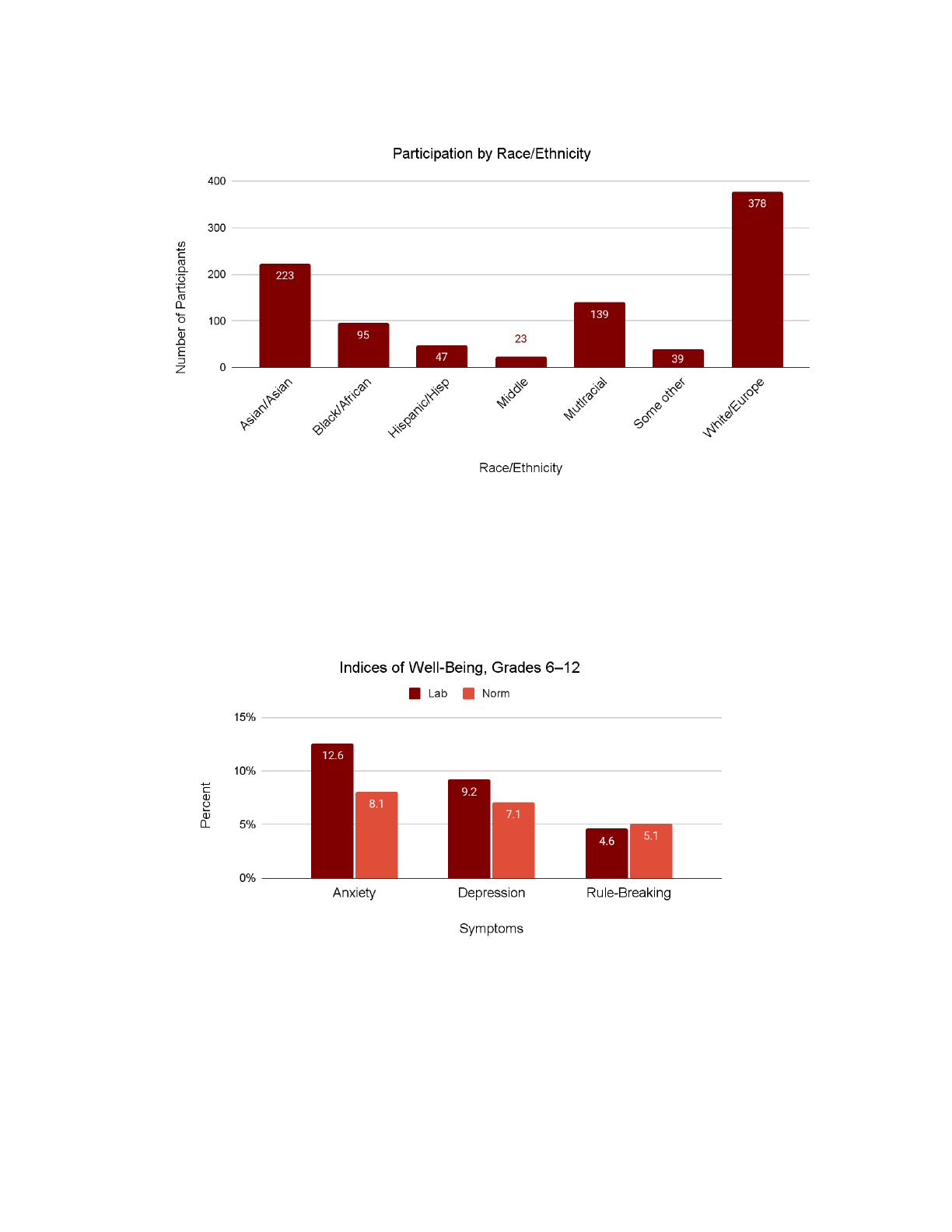
Well-Being Index and Mental Health Symptoms
The Well-Being Index (WBI) is a tool developed by Authentic Connections that gives schools a sense of an
overall measure of the mental health of the students in their school. The Lab student community’s
well-being was rated 85% as compared to a national norm of 85.5%, with 100% being the highest score
possible for the healthiest community.
Authentic Connections defines “well-being” as the lack of five clinically significant core mental health
symptoms: anxiety, depression, rule-breaking behaviors, substance use, and isolation at school.
Anxiety and depression symptoms represent students’ internal expression of their mental health
difficulties, while rule-breaking (e.g., cheating on tests, stealing, breaking at rules at home or school) and
Page 13/35

substance use (drugs, tobacco, alcohol) behaviors are external expressions of students’ struggles.
Isolation at school is considered because school-based relationships can have a significant impact on
students’ overall well-being.
Prevalence of Anxiety and Depression
At Lab, students reported significant symptoms of anxiety and depression in the past six months at a
higher rate than the national norm
1
:
● 12.6% of students reported experiencing symptoms of anxiety, which is 5% higher than the
national norm of 8.1%.
● Nine percent of students reported symptoms of depression, compared to 7% of students
nationally.
Authentic Connections discerned patterns in our data indicating that students may be at higher risk for
anxiety and depression if they identify with certain personal characteristics. In particular:
● Lab students who identify as non-binary were most likely to report high levels of anxiety and
depression.
● Girls at Lab were more likely to report high levels of anxiety than boys, although boys were more
likely than girls to report symptoms of depression.
●
Lab students of all races/ethnicities more frequently reported high levels of anxiety than national
norms based on race/ethnicity. Lab students who identify as Latinx or white were the most likely
to report those symptoms.
● Lab students who identify as white or Multiracial were most likely to report significant levels of
depression.
1
The Authentic Connections Well-Being Index classifies students as in the clinically significant range for anxiety and
depression when their reported symptoms are over two standard deviations from the mean.
Page 14/35
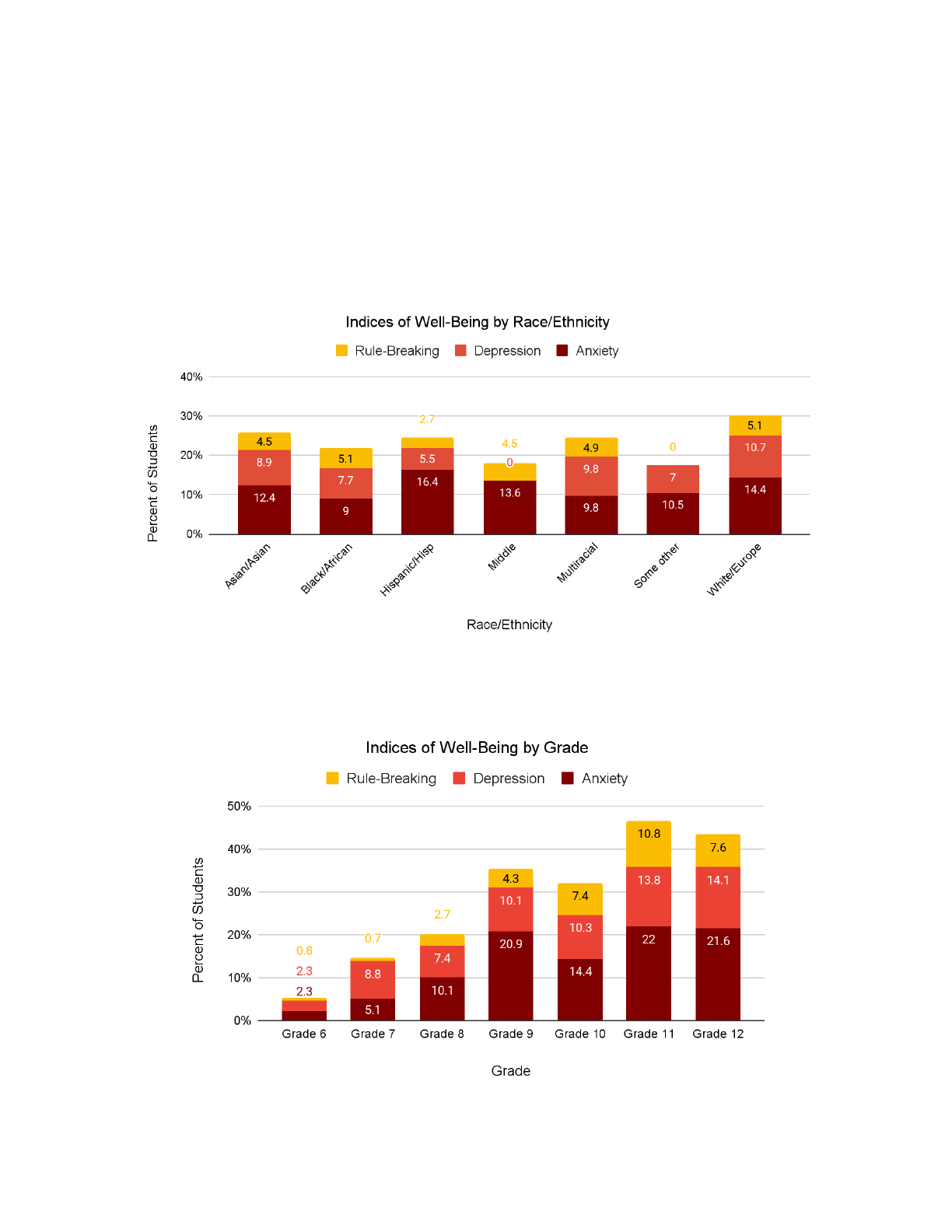
Our data also revealed patterns by grade, in particular:
● High school students more frequently reported high levels of anxiety and depression than
Middle School students.
● Students in grades 8 through 12 were more likely to report high levels of anxiety than the
national norm.
●
Lab students in grades 7 through 12 more frequently reported high levels of depression than
national grade-based norms.
Page 15/35

Prevalence of Rule-Breaking and Substance Use Behaviors
Overall, students at Lab were slightly less likely to report rule-breaking behavior in the past six months
than the national norm. 4.6% of Lab students reported rule-breaking behaviors as compared to the
national norm of 5.1%.
However, the following patterns by identity and grade emerged:
● Lab students in grades 9 through 12 were more likely to report having engaged in rule-breaking
behaviors than the national norm.
● Girls and non-binary students were the most likely to report rule-breaking behaviors, with both
groups reporting at a higher rate than national norm for their respective genders.
Authentic Connections surveyed students about their alcohol, marijuana, vaping, and cigarette use in the
previous month, and gauged clinically significant substance use on a monthly basis.
2
By these measures,
Lab students were slightly less likely than the national norm to experience substance use issues. This
finding holds true across all substance types, and the data revealed no marked differences in substance
use rates among student subgroups based on gender or race/ethnicity. Older students were more likely
to use substances than younger students, but each grade reported less frequent use than the national
2
Clinically significant substance use, on a monthly basis, is defined by Authentic Connections based on these
minimum values:
Alcohol: 6-9 times for boys and girls
Being “drunk”: 6-9 times for boys and girls
Cigarettes: 1-5 times for boys and girls
Marijuana: 6-9 times for boys and girls
Vaping: 10-39 times for boys, and 6-9 times for girls
Page 16/35
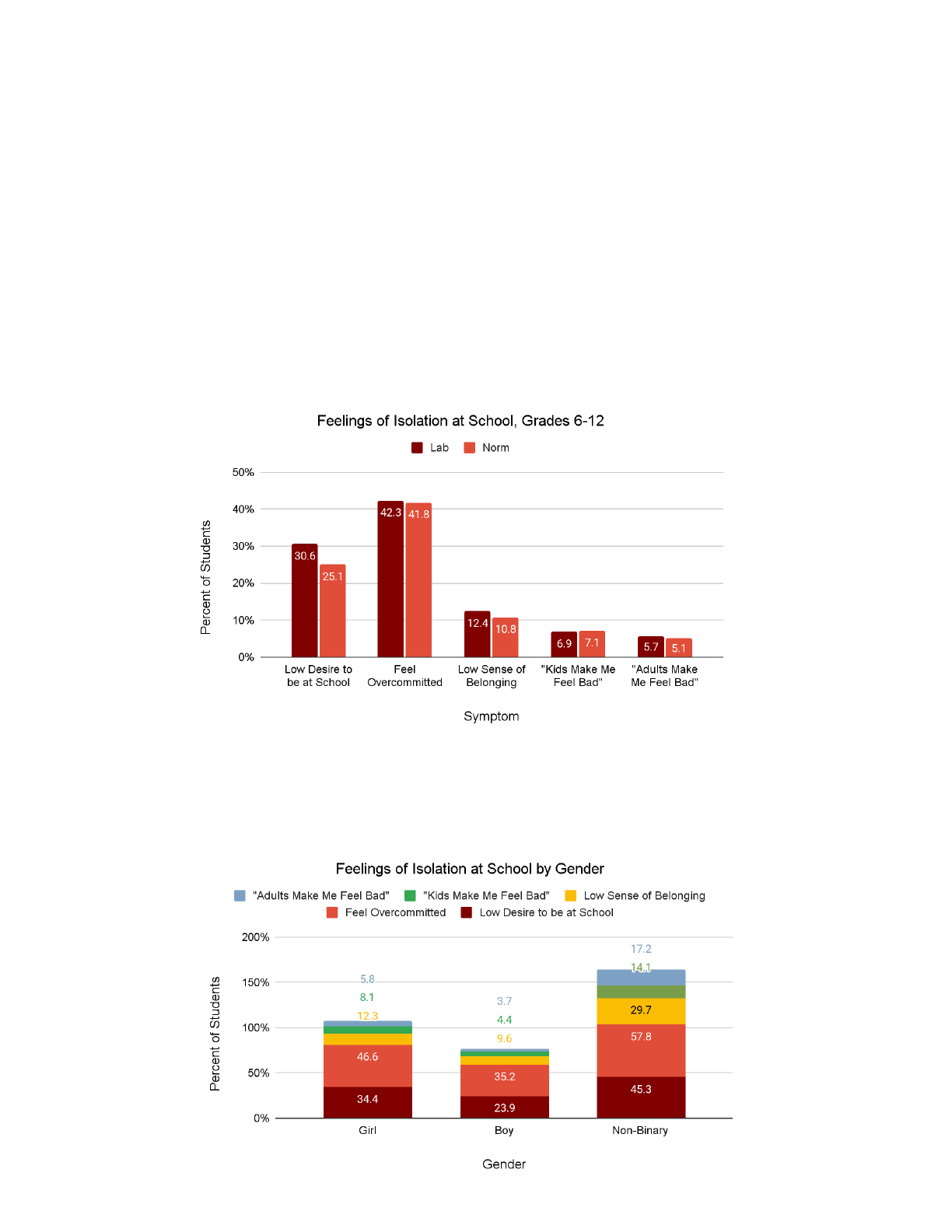
norm for the respective grade. No students in Middle School reported clinically significant substance use
for marijuana, vaping, or cigarettes. Less than 1% of Middle School students reported significant alcohol
use and no students reported clinically significant intoxication issues.
Prevalence of Feelings of Isolation at School
To assess whether students experienced high isolation at school/low feelings about school in the past six
months, they were asked questions about five topics: how much they desired to be at school, whether
they felt like they belonged, if they felt overcommitted, and whether they were made to “feel bad” at
school either by adults or by fellow students. Generally, Lab students’ feelings of isolation at school were
consistent with national norms, except that Lab students at Lab were more likely to report a “low desire
to be at school” (30.6%) than the national norm of 25.1%.
Notable patterns by personal identity emerged as follows:
● Non-binary students and girls at Lab were more likely to report symptoms of isolation than
national norms based on gender.
Page 17/35

Correlations and Focus Areas
Throughout the survey, students were asked quantitative and open-ended questions about more than 50
aspects of student life. For example, the survey asked students to rate fairness at school, equity/inclusion
at school, parent/guardian criticism, and their social media use. Authentic Connections categorizes
aspects of student life by students’ relationship types: relationship to school or “school climate” (e.g.,
bullying climate, school structures and schedules), relationships with peers (e.g., envy, peer sexual
harassment), and relationships with parents/guardians (e.g., conversations about grades, parent
criticism).
Students’ responses on these topics were then compared with their responses about well-being. Based
on this analysis, Authentic Connections identified nine aspects of student life at Lab that most strongly
correlate with students’ mental health difficulties. Those nine aspects of student life are Lab’s Focus
Areas.
Below are detailed findings about these nine aspects of student life. They are grouped by relationship
type according to Authentic Connections’ practice. We include data about how many Lab students report
experiencing these issues, as well as notable connections between these issues and students’ personal
identity. As noted in the Executive Summary, it is important to understand that the significance of the
Focus Areas is less about their prevalence at Lab than their close correlation with mental health
symptoms in our community. That is, these aspects of student life are not necessarily highly or unusually
prevalent in our community; rather, they are strongly correlated with students’ mental health symptoms.
They are our Focus Areas in the sense that they predict where our community’s efforts will have the
greatest impact.
School Climate
1. Equity and Inclusion. Where students reported feeling that there is low equity and inclusion at
Lab, they were more likely to report mental health symptoms. “Low equity and inclusion” refers
to students’ feelings that in general, members of the Lab school community treat each other
differently based on various aspects of identity—including gender, learning
Page 18/35
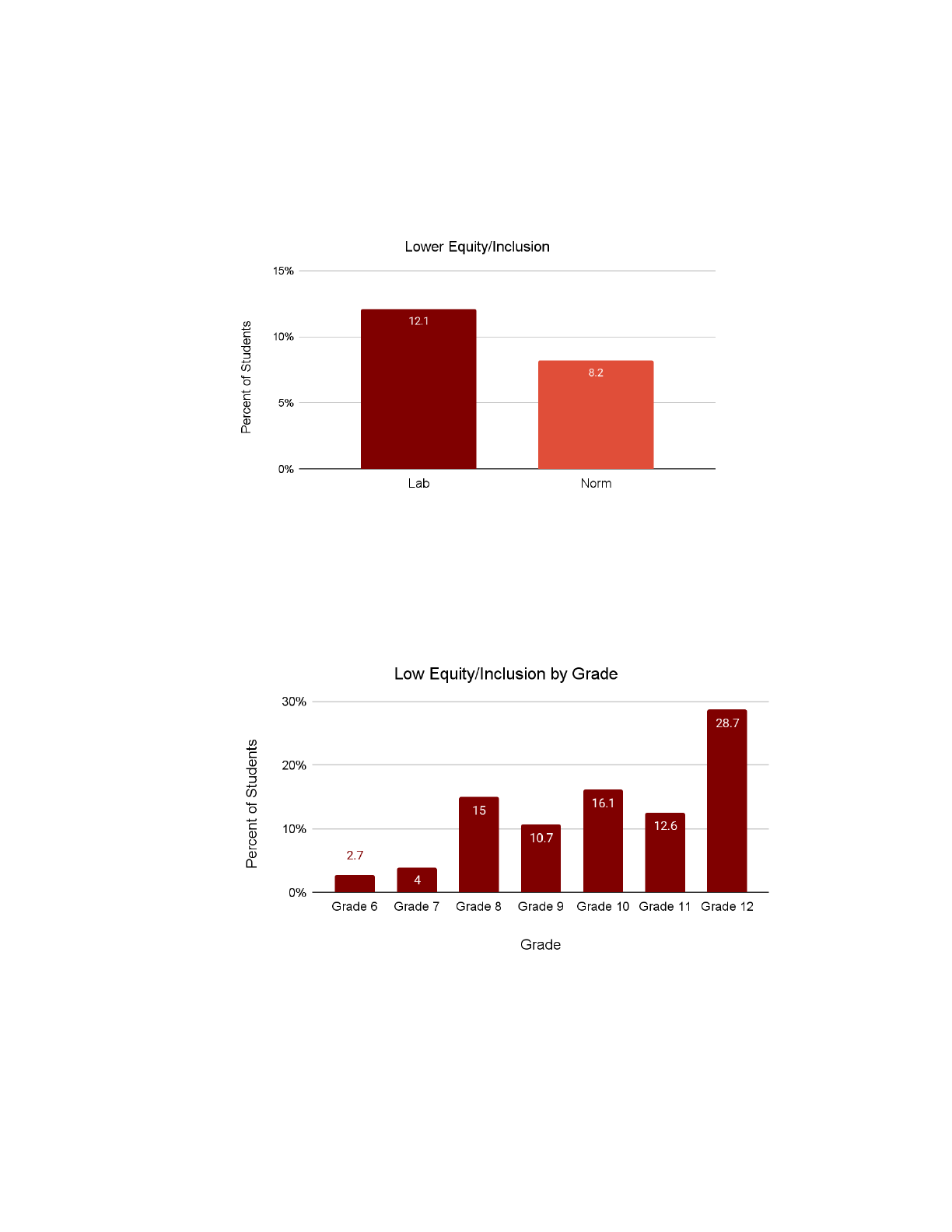
differences/neurodiversity, physical (dis)ability status, political views, race and/or ethnicity, and
sexual orientation. Noteworthy conclusions were:
● In general, Lab students were more likely to report feeling low equity and inclusion
(12.1%) than the national norm of 8.2%.
●
Of the aspects of identity covered by the survey, students were most likely to agree that
the school community treated people differently based on their political views.
● Older students and girls (13.8%) and non-binary identifying students (25.2%) were the
most likely to report feeling there is low equity and inclusion at Lab.
Page 19/35
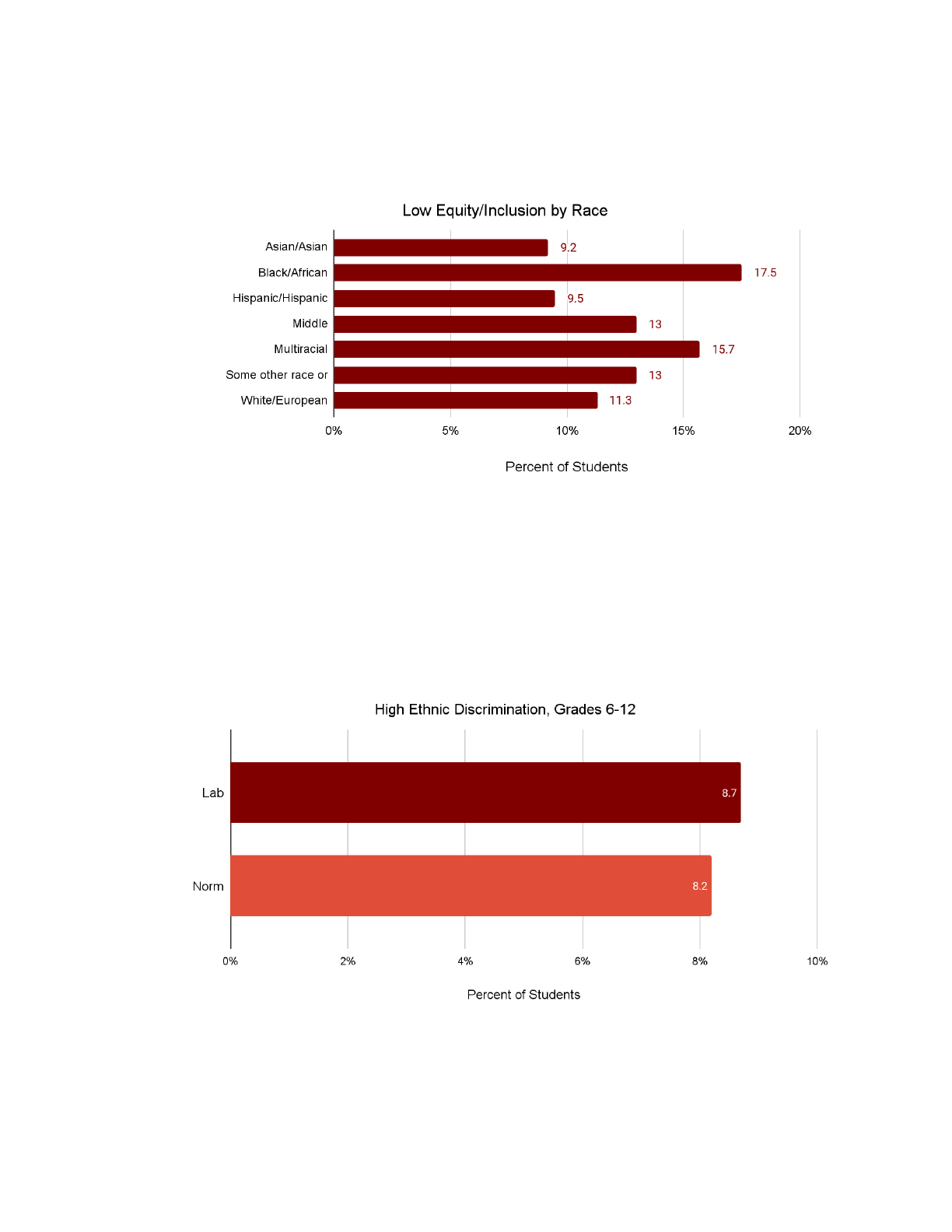
● Black students and multiracial students were the most likely to report low equity and
inclusion at Lab.
2. Ethnic discrimination. Where students reported personally experiencing high ethnic
discrimination at Lab, they were more likely to report mental health symptoms. “High ethnic
discrimination” refers to students’ feelings that they personally have been discriminated against
at Lab because of their race and/or ethnicity.
● Overall, the rate at which Lab students report experiencing high ethnic discrimination
(8.7%) is comparable to the national norm of 8%.
●
Students’ experiences of ethnic discrimination at Lab vary based on their racial/ethnic
identities. Black students were most likely to report having personally experienced
discrimination: 29.2% of Black students reported experiencing discrimination, compared
Page 20/35
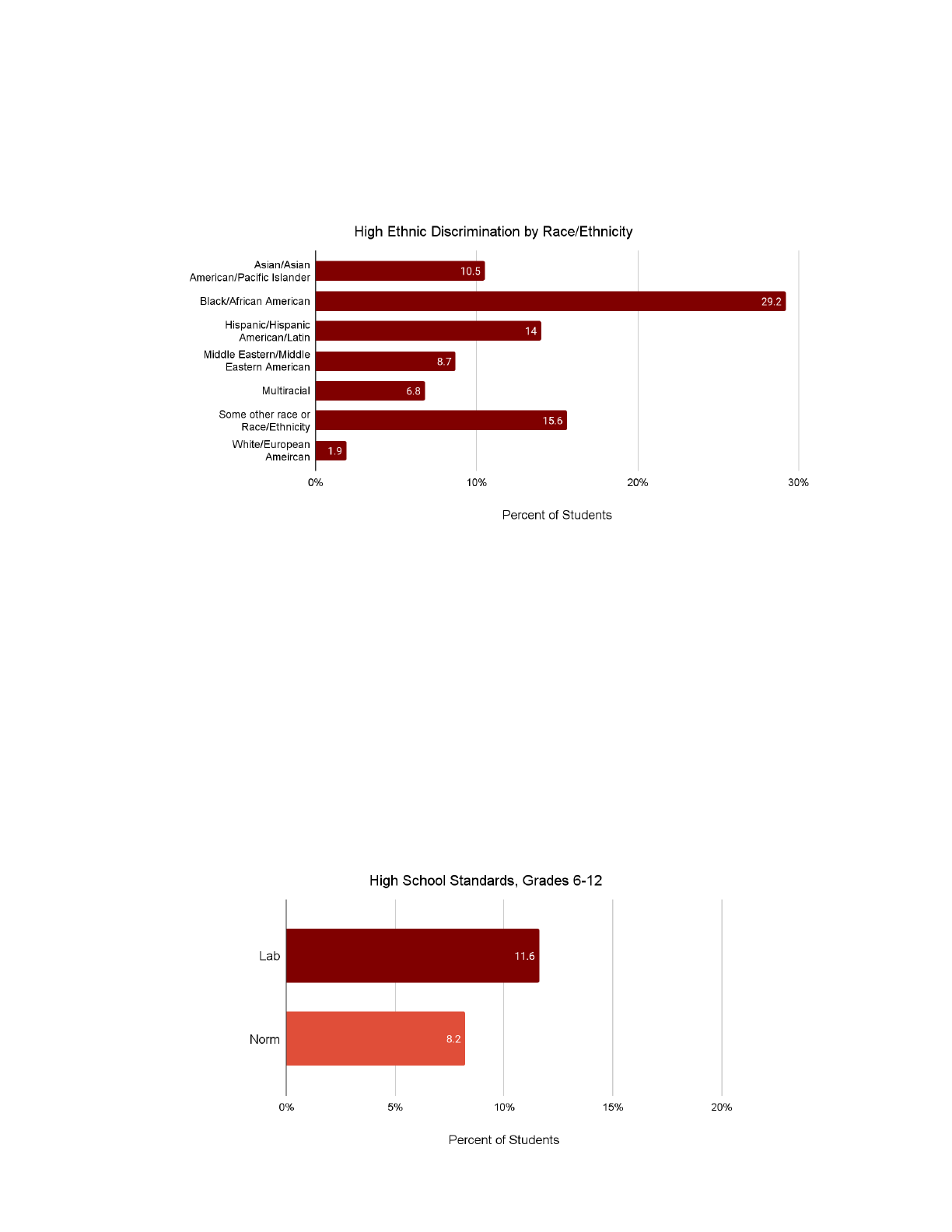
to 15.6% of students who identified as “some other race or ethnicity,” 14% of Latinx
students, 10.5% of students of Asian descent, 7% of multiracial students, and 1.9% of
white students.
● Overall, older students were more likely to report personally experiencing discrimination
than younger students (e.g., 16.7% of students in grade 12 as compared to 4.7% of
students in grade 7).
3. School standards. Where students reported feeling that standards at Lab are high, they were
more likely to report mental health symptoms. “High standards at school” refers to students’
experience that teachers and adults at school are “overly critical, disapproving, and impossible
to please.”
● Overall, 11.6% of students reported feeling that teachers and adults’ standards at Lab
are high, as compared to national norms of 8.2%.
Page 21/35

● Students who identified as non-binary (19%) or as girls (13.9%) were more likely to
report high school standards than boys (7.9%).
● Students in grades 8, 11, and 12 were the most likely to report high school standards.
Students’ Relationships with Peers
4. Peer Victimization. Where students reported experiences of peer victimization—that is, bullying,
harassment, or exclusion by their fellow students—they were more likely to report mental health
symptoms. In particular, students who reported high rates of victimization were more likely to
report higher symptoms of isolation at school.
● At Lab this aspect of student life tracks below the national norm: 2.4% of Lab students as
compared to 6.3% nationally.
●
Non-binary students, white students, and students in the 9th grade were most likely to
report high rates of victimization by peers.
● Of the behaviors identified by students, the most frequently cited were experiences that
peers spread rumors behind their backs and that peers intentionally exclude or make
them feel left out.
Page 22/35
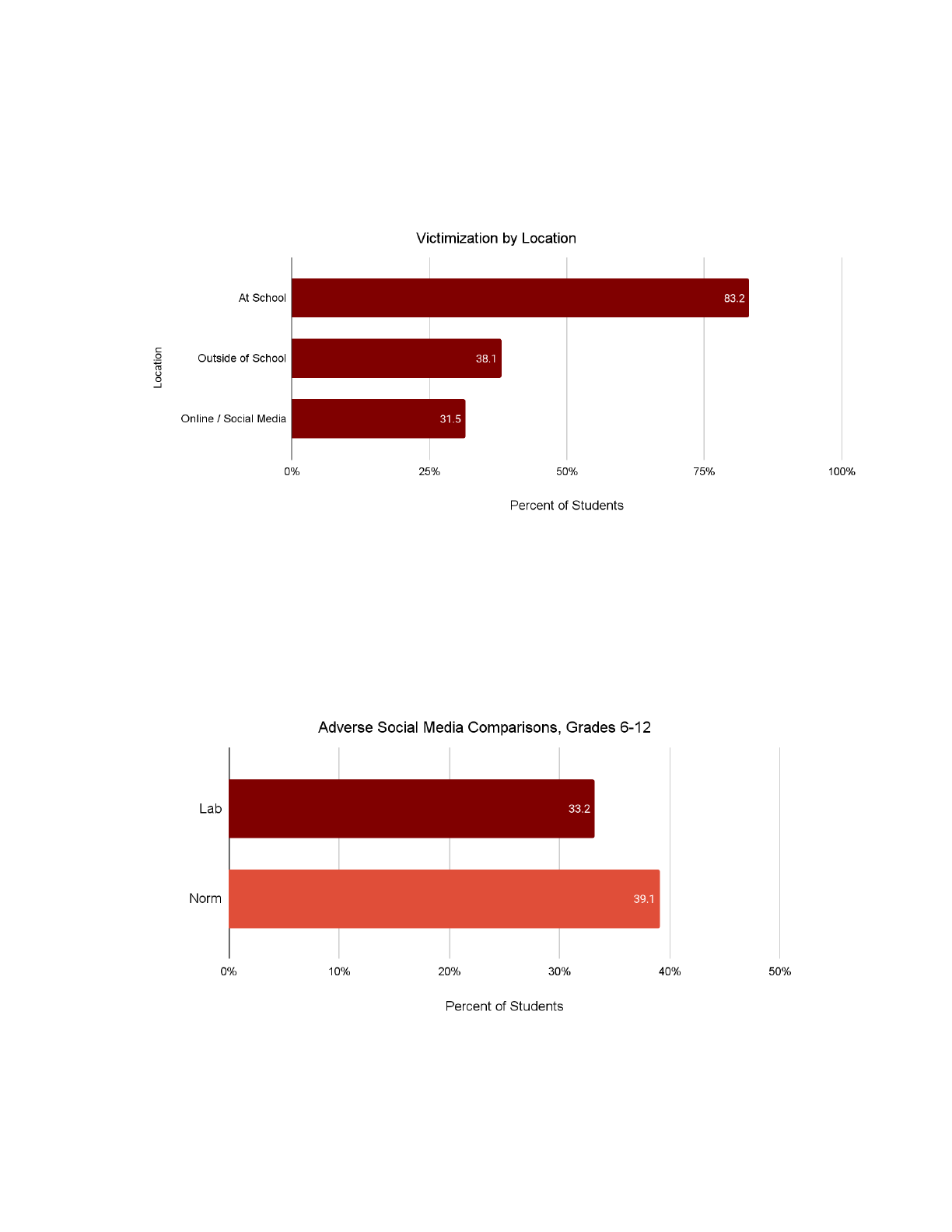
● When students were asked about all the locations where they had experienced
victimization, 83.2% of students said the victimizing behaviors happened at school,
38.1% said they happened outside of school, and 31.5% said they happened online or on
social media.
5. Adverse Social Media Comparisons. Where students reported that they feel worse about
themselves after viewing others’ social media, they were more likely to report mental health
symptoms.
● 33.2% of Lab students reported that they tend to feel worse about themselves after
viewing others’ social media, as compared to the national norm of 39.1%.
Page 23/35
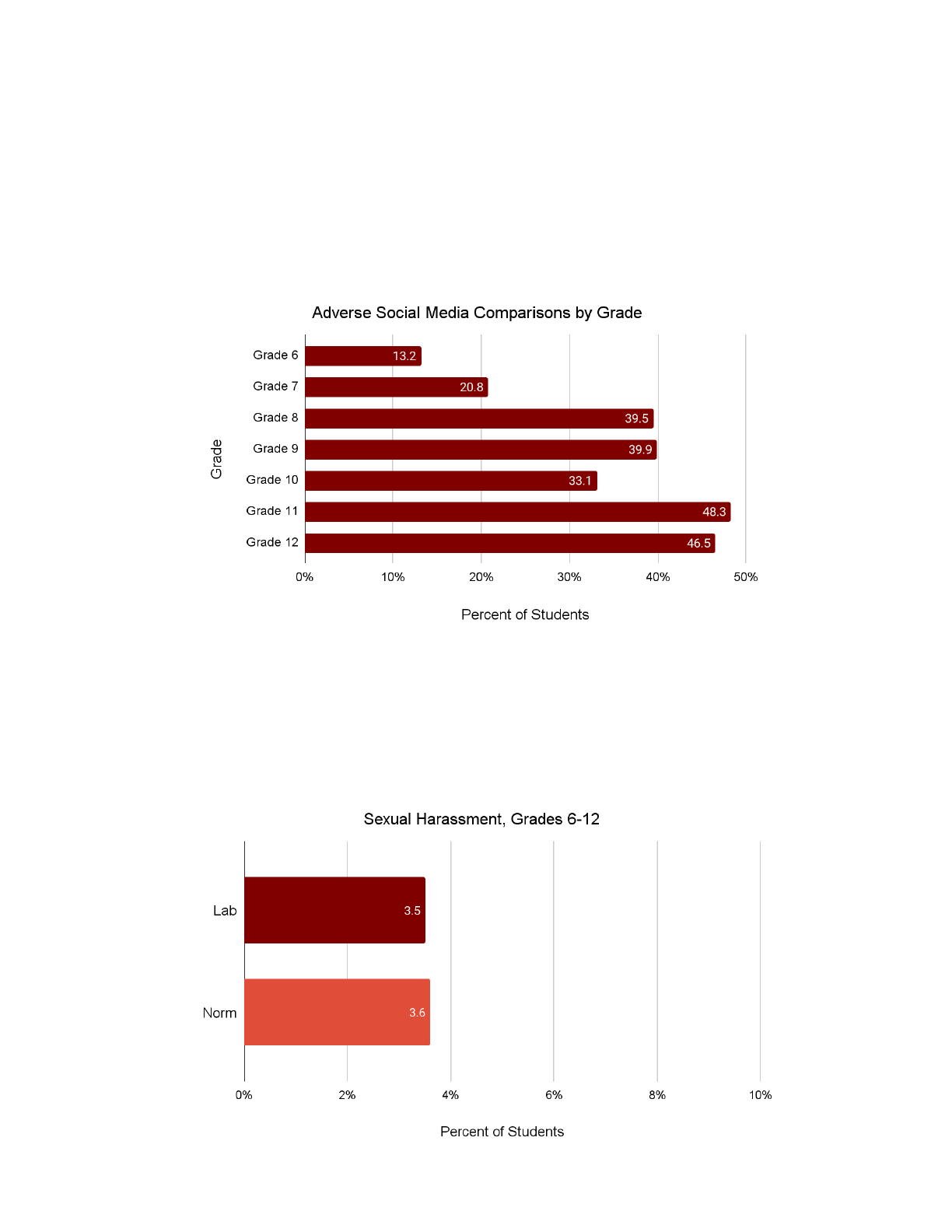
● Girls (46.6%) and non-binary students (41.5%) were more than twice as likely to report
adverse social media comparisons than boys (17.4%).
● There was a substantial correlation between adverse social media comparisons and
symptoms of depression and anxiety for both boys and girls, but especially for girls and
non-binary students.
● Students in grades 8 through 12 were most likely to report adverse social media
comparisons.
6. Sexual Harassment. Where students reported that they personally have been sexually harassed
by a school peer—for example, that they have experienced unwanted sexual contact, heard
unwelcome sexual comments or jokes, or received unwanted sexual images—they were more
likely to report mental health symptoms.
● Overall, 3.5% of Lab students reported experiencing high rates of peer sexual
harassment, which is consistent with the national norm of 3.6%.
Page 24/35

● Generally, older students were more likely than younger students to report peer sexual
harassment.
● Generally, girls (4.9%) and non-binary-identifying students (4.6%) were more likely than
boys (1.9%) to report peer sexual harassment.
● There is a particularly strong correlation between experiencing sexual harassment and
anxiety symptoms for boys.
● When students were asked to identify all the locations where they had experienced
harassment from peers, 59% said the interactions happened at school, 46% said they
happened online, and 44% said they happened outside of school.
Students’ Relationships with Parents/Guardians
7. Parent Mood. Where students reported perceiving that at least one of their parents/guardians
has seemed depressed, tired, stressed, or irritable, the students were more likely to report
mental health symptoms.
● At Lab, 4% students reported concerns about their parents’/guardians’ mood, as
compared to the national norm of 3%.
● There was an especially strong correlation between low parent mood and symptoms of
anxiety and/or depression for boys.
Page 25/35
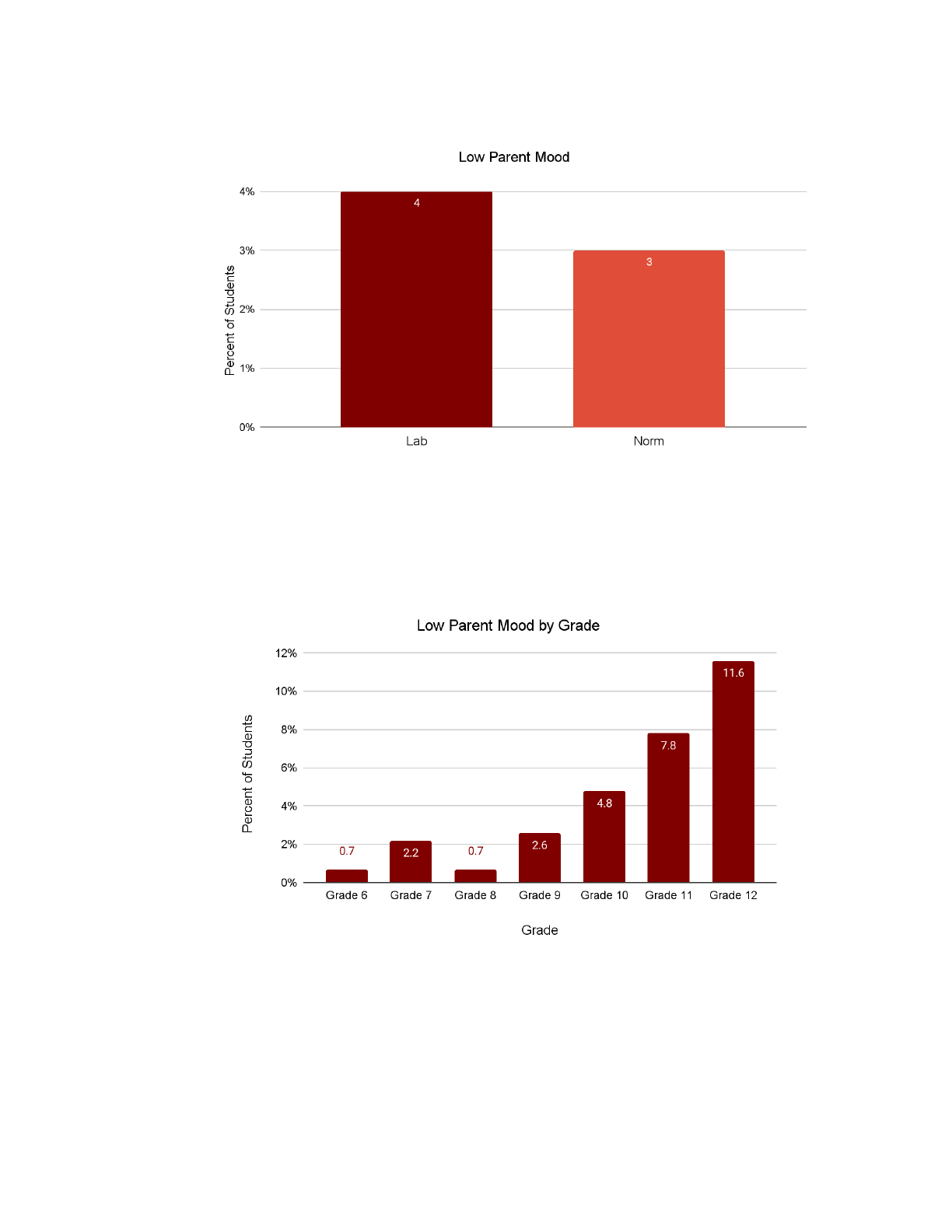
●
Overall, girls (6%) were more likely to report low parent mood than boys (2.3%) or
nonbinary students (1.5%).
● Students in grades 11 and 12 were much more likely to report low parent mood than
students in other grades.
Page 26/35

8. Lenient Parent Consequences for Drugs. Where students reported that their parents/guardians
maintain permissive rules or lenient consequences regarding drug or alcohol use, the students
were more likely to report mental health symptoms.
● At Lab, 5% of students reported feeling that their parents/guardians’ rules and
consequences around drugs and alcohol use are not serious, as compared to the
national norm of 8%.
●
Generally, older students were more likely to report their parents/guardians'
consequences were not serious.
● There were no meaningful differences on this topic among students based on gender
identity.
Page 27/35

9. Hyper-parenting over grades. Where students reported feeling more upset than cared for when
talking to their parents/guardians about their grades, they were more likely to report mental
health symptoms.
● At Lab, 22.6% of students reported feeling more upset than cared for when talking to
their parents/guardians about grades, higher than the national norm of 19%.
● Depression and anxiety were particularly prevalent in such cases, and among boys, low
feelings about school.
● Older students were especially likely to report concerns about hyper-parenting over
grades.
Page 28/35

● Hyper-parenting over grades was reported at the highest rates among students who
identified as Latinx (35.6%), Asian descent (24.2%), or multiracial (24.4%).
● Girls (25.4%) and nonbinary students (30.3%) were more likely to report feeling more
upset than cared for in such conversations than boys (18.7%) at Lab.
Student Responses to Open-Ended Questions
In addition to quantitative questions, students were asked open-ended questions in the High Achieving
Schools Survey. Authentic Connections analyzed the students’ responses to open-ended questions to
assess areas of strength, areas for improvement, students’ concerns, and ways to increase equity and
inclusion at Lab. For each of these four topics, we have summarized Authentic Connections’ analysis and
provided sample, anonymized student responses.
Areas of Strength
When students were asked what things Lab is doing well to support their overall school
experience and well-being, the most frequently mentioned themes were faculty emotional
support, the school structure or schedule, and faculty academic support. When students’
responses were viewed by grade, Middle School students were more likely to mention faculty
emotional support as a strength at Lab than students in the High School, although it was a
prevalent theme across all grades. Students in grades 8 and 11 were the most likely to report
“school structure or schedule” as a strength. Middle School students were more likely to report
“activities, athletics, or events” as a strength than High School students, while High School
students were more likely to report “faculty flexibility” as a strength.
Sample quotes from students who identified faculty emotional support as a strength:
● Grade 6 Student: “I like how teachers a school ask me ‘How is your day’ and if you said,
‘bad’ they’ll ask you why”
● Grade 7 Student: “They reach out to help me when they see me struggling.”
● Grade 10 Student: “The school is doing a good job at making sure everyone feels
included and accepted in the school environment.”
● Grade 11 Student: “They make sure to make students aware of resources like counselors
or teachers.”
Some students who noted structure/schedule as a strength wrote:
● Grade 7 Student: “I really enjoy that there are no core classes in the second part of the
day (after lunch) it helps me get more organized.”
● Grade 9 Student: “free periods” and “giving me breaks”
● Grade 11 Student: “providing mental health days”
Areas for Improvement
When students were asked what their teachers/faculty could be doing to improve things for
them, the most frequently mentioned themes were their workload, faculty emotional support,
Page 29/35

and faculty flexibility. When students’ responses were viewed by grade, students in grades 7
through 11 were most likely to mention the volume of their academic assignments and faculty
emotional support. Students in grade 12 most frequently mentioned themes were faculty
emotional support and faculty flexibility.
Sample quotes from students who mentioned workload as an area for improvement:
● Grade 7 Student: “I am happy that I am learning a lot but I am extremely overwhelmed
by homework. I usually have more than three hours of homework a day… I would want
the faculty to make sure we never have over two hours of homework a day. Maybe a
no-homework day each week where homework cannot be assigned or due would help.”
● Grade 8 Student: “I think teachers could understand that we get homework in other
classes and not just in their class so they can be a little more considerate when giving a
lot of homework.”
● Grade 9 Student: “Assign less homework.”
● Grand 10 Student: “Give less homework and coordinate with each other to make sure
their major tests and due dates don’t all fall on the same day.”
● Grade 11 Student: “Take into account students with lengthy extracurriculars when
assigning homework more often.”
Sample quotes from students who mentioned faculty emotional support as an area for
improvement:
● Grade 6 Student: “Providing more study guides before tests.”
● Grade 6 Student: “Explaining assignments more clearly, and not having assignments due
the day after when assigned.”
● Grade 7 Student: “check in with me every once in a while”
● Grade 8 Student: “Not put as much pressure to be perfect all the time.”
● Grade 9 Student: “putting less pressure”
● Grade 10 Student: “Listen to what students request to make their learning environment
better. For example, if they say their eyesight is not the best, consider putting them in
the front of the class… treat all students the same and don’t have certain biases toward
certain students.”
● Grade 12 Student: “Ask us how we’re doing more often.”
Students’ Concerns
When students were asked what they are most worried about these days, the most frequently
mentioned themes were academic performance, assignments, college, and peer interactions. For
example, students described being worried about “grades” and “being a disappointment to my
parents,” “homework” and “getting everything done on time,” and “losing friends” and “being
embarrassed.”
Sample quotes from students who said they were worried about academic performance:
Page 30/35

● Grade 6 Student: “I am worried about not doing well on tests and quizzes and about not
finishing all my homework.”
● Grade 8 Student: “Getting good grades, working towards college.”
● Grade 10 Student: “Not living up to my own standards.”
● Grade 11 Student: “My grades and upcoming tests/assignments are my biggest worries.”
Sample quotes from 12th grade students who said they were worried about college:
● “I’m most worried about getting into a college of my choice.”
● “College applications and balancing them with schoolwork.”
● “I am most worried about college-related issues because of the toxic student climate
regarding college applications. Students push their own stress about school/college on
others.”
Some students who expressed concern about peer interactions wrote:
● Grade 6 Student: “…people talking bad things about me.”
● Grade 7 Student: “...losing all my friends, having everyone judge me.”
● Grade 10 Student: “I feel slightly paranoid that I’m being a nuisance to some of my
friends.”
● Grade 11 Student: “Problems with friends.”
● Grade 12 Student: “...maintaining relationships, making sure that I’m growing as a
person and helping those around me.”
Ways to Increase Equity and Inclusion
Students were asked which school policies, practices, or traditions, if any, they would modify to
increase equity and inclusion. Their suggestions included celebrating more religious holidays,
gender-inclusive bathrooms, more DEI programming in classrooms, education around disabilities,
and diversifying the student body and staff.
Sample suggestions from students, by grade:
● Grade 6 Students: “I would add more non-binary bathrooms.” “I would have more
festivals for every religion and celebrate all the holidays that other religions celebrate.”
● Grade 7 Students: “More DEI classes.” “More diversity in the staff.” “We don’t talk much
about issues regarding socioeconomic status or people who have different
physical/mental abilities.”
● Grade 9 Students: “I would encourage students and faculty to just be more mindful of
mental disabilities like OCD and sensory induced anxiety.” “Making the school more
affordable for lower and middle class families.” “Asking for pronouns.” “Have more
classes like those at the Brave conference.”
● Grade 9 Students: “Thinking more about political viewpoints [...] I think it is important to
‘reach across the aisle.’” “Create more spaces where people feel welcome for being who
they are.”
Page 31/35

● Grade 10 Students: “Mak[e] more accessible spaces for people with disabilities.” “Having
more opportunities to help the less fortunate.” “Not schedule tests on religious
holidays.”
● Grade 11 Students: “Having inclusivity training for teachers.” “Have smaller but more
common discussions about diversity, [because] diversity days/assemblies though well
intended do not address the root cause.”
● Grade 12 Students: “Diversify the school. Not only the student body but also faculty.”
“Accommodations should be more easily available.”
Page 32/35

III. Frequently Asked Questions
Why did Lab choose to partner with Authentic Connections?
To further Lab’s response to the national youth mental health crisis and to gain an accurate picture of
students’ experiences, behaviors, identities, outlook, perspectives, and social-emotional lives, we chose
to partner with a third-party, expert provider to survey students about wellness in grades 6–12.
Authentic Connections is highly regarded, has partnered with a large number of schools like ours, and
brings considerable professional expertise to the task of designing, implementing, and analyzing school
surveys. The survey used at Lab this fall, the High Achieving Schools Survey, was designed to “assess
mental health and modifiable aspects of personal and community life that can be targeted to improve
well-being.” Authentic Connections was able to provide us with a benchmarked analysis of our results as
compared nationally to 78,264 students in 201 schools, and an expert, research-informed opinion on our
path forward.
What is the Well-Being Index?
The Well-Being Index (WBI) is a tool developed by Authentic Connections that gives schools a sense of
the overall health of their school. Authentic Connections defines well-being as the lack of clinically
significant core mental health symptoms: anxiety, depression, rule-breaking behaviors, substance use,
and isolation at school. Anxiety and depression symptoms represent students’ internal expression of
their mental health difficulties, while rule-breaking and substance use behaviors are external expressions
of students’ struggles. The WBI also measures isolation at school because school-based relationships can
have a significant impact on students’ overall well-being. For each component, five questions were posed
to assess how frequently students experienced the symptom on a 5-point scale (0 = never, 4 = very
often). Answers to these questions are compiled and analyzed, resulting in the Well-Being Index, a
psychometrically-validated measure of adolescent mental health symptoms developed by researchers at
Authentic Connections. Overall, the Lab student community’s well-being was rated 85% as compared to
a national norm of 85.5%, with 100% being the highest score possible for the healthiest community.
How does Authentic Connections determine “focus areas” for intervention?
The survey assessed more than 50 aspects of student life—such as bullying climate, school fairness,
equity/inclusion, and student relationships. Authentic Connections assigns an overall score for each
aspect by compiling the results to several related questions. For example, to gather information about
“bullying climate” at Lab, students are asked to what extent they agree or disagree with the following:
(1) “students harass, bully, or are mean to other students,” (2) “students at this school are often teased
or picked on,” and (3) “most students in this school like to put each other down.” The score for each
aspect of student life can then be compared to national norms. To identify Lab’s focus areas and
recommendations, Authentic Connections conducted multiple regression analyses to identify which
aspects of student life are most strongly linked to student wellbeing symptoms. These aspects of student
life may or may not be prevalent at Lab; their significance lies in the fact that they closely correlate with
symptoms of mental health difficulties. Finally, Authentic Connections identifies areas of strength and
areas for improvement based on students’ responses to open-ended questions. Students’ written
Page 33/35

responses are assessed for certain themes, and the frequency with which those themes are mentioned
in the student comments determines whether they are an area of strength or improvement.
What can we do to increase students’ participation in the survey?
In future, we hope to increase High School student participation by administering the survey during
advisory. This year, the survey was administered during Middle School advisory and during assembly
period for High School students.
We do not expect to achieve 100% participation in health and wellness surveys. It is important that
students feel safe and comfortable when taking a survey like this, and that they should not feel forced to
answer sensitive questions about their mental well-being and experiences. Students were encouraged to
participate honestly, and were advised that if they became uncomfortable at any point during the survey,
they could excuse themselves to go to speak with an adult in Learning and Counseling. Further,
parents/guardians were advised in advance that their child could decline to participate in the survey.
Where did the gender identity descriptors come from?
All identity descriptors in the survey instrument and this report are those used by Authentic
Connections. We understand that Authentic Connections’ categories may not have been an ideal fit for
every student who participated in the survey. For example, in the survey, students were asked to share
which gender they most identify with from the following list: Boy / Man, Girl / Woman, Non-binary,
Genderqueer, Gender-fluid, Agender, Unsure, Prefer not to answer, and Prefer to self-describe. Students
were separately asked whether they identified as transgender. To protect anonymity by aggregating
responses and to produce meaningful comparisons, Authentic Connections combined the categories of
Non-binary, Genderqueer, Gender-fluid, and Agender under a single heading of “nonbinary” when
presenting the results. Students who identified as transgender were included in the binary gender with
which they identify, meaning that a student who identifies as a transgender girl was included in the
“girls” category.
This is a departure from practices at Lab, where we feel that combining students’ genders under a single
heading is not the best way of affirming their identities. The Laboratory Schools strive to honor individual
identity as an essential component of both personhood and community. When Lab seeks information
about identity, we do not impose the answers but rather ask our community members. In particular, as
our policies make clear, the responsibility and agency for determining a student’s gender identity rests
with the student. Still, we felt that however imperfect were Authentic Connections’ categories, the great
advantage of using them was the opportunity to compare Lab to over two hundred schools nationwide
which have used the same survey instrument.
How did Lab determine which questions to ask (and not ask) this year?
The questions presented in the survey instrument were developed and scientifically validated by
Authentic Connections. Lab felt confident in this survey because it is grounded in three decades of
peer-reviewed scientific research, and thus it allowed us to learn about the prevalence at our school of
Page 34/35

mental health difficulties (e.g., depression and anxiety) and their potential drivers (e.g., envy or being
bullied at school).
The Authentic Connections survey does not directly or explicitly ask questions about certain risk
behaviors such as suicide ideation. This is a departure from previous health and wellness surveys
developed and implemented at Lab. However, although Authentic Connections does not directly ask
about such risk behaviors, its survey is designed to provide a thorough evaluation of mental health
difficulties and aspects of student life that drive those risk behaviors. The questions posed were intended
to help Lab take action to prevent risk behaviors by addressing their root causes.
Who oversees wellness at Lab?
At Lab, we take a multifaceted, collaborative approach to student wellness. Our Nursing team is the first
point of contact for students with acute or chronic illnesses or injuries. Individualized support for
students’ mental health needs and learning needs is provided by the Learning and Counseling team, led
by Director of Student Services Nicole Neal. The Learning and Counseling team works closely with
divisional deans of students and other administrators, including Director of Diversity, Equity, and
Inclusion Nicole Williams and Director of Equal Opportunity Programs Betsy Noel. Each Middle and High
School student is also assigned to an advisory group, led by a faculty advisor, to encourage relationships
and support among students in a small-group setting. All school employees who work directly with
students are trained to support students’ wellness in a variety of ways. As mentioned in the Mental
Health Support at Lab section in the Executive Summary, it is important to note that over 170 of
educators at Lab are now trained in YMHFA.
What is Lab’s plan for conducting surveys in the future?
We plan to administer a broad health and wellness survey like this every other year at Lab. In the
intervening years, we will solicit information from community members in other ways on a variety of
topics. For example, next year we will seek feedback from across the Laboratory Schools community on a
number of aspects of the Lab experience through our ISACS Community Survey, which launches our
reaccreditation cycle.
Where do I go if I have a concern?
Students, parents and employees can report concerns about health and wellness through a variety of
methods. Students and parents are encouraged to approach the dean of students or a school counselor
in their division; alternately, division principals, assistant principals, and trusted teachers and coaches are
available as support resources for students. Community members with concerns about violations of Lab’s
harassment or bullying policies or other peer victimization issues are encouraged to reach out to Director
of Equal Opportunity Services and Deputy Title IX Coordinator Betsy Noel at [email protected]o.edu.
Community members may also elect to submit a concern anonymously or under your name through our
online Bias Reporting Form, which can be found on Lab’s Equal Opportunity webpage . Employees are
trained in identifying safety situations which must be reported, and regular structures are provided as
described above for employees to bring forward concerns about students in an appropriate way.
Page 35/35
